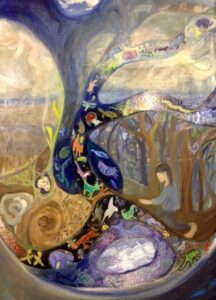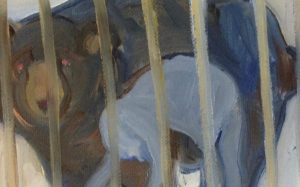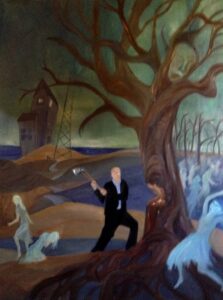 The Myth of Erysichthon and his Daughter: An Invitation to Radical Metamorphosis
The Myth of Erysichthon and his Daughter: An Invitation to Radical Metamorphosis
“There are many people who can change once and stay that way forever. There are others who have the power to change as often as they like. Mestra, daughter of King Erysichthon, had this power.”
…So begins Ovid’s ancient myth –not with a description of the all powerful, earth-destroying arrogant protagonist, but with his daughter who really only shows up in the last act….That’s the the thing that I find most absorbing in t he story, and what has driven me, and artist Linda Ganus, to play with it over the past six months. The results are on display as an installationof paintings and animation at Nurture Nature Center, beginning November 4th, 2017.
A classicist would tell you Erysichthon’s tale originated around 1000 BC, when Greeks were clear cutting vast Mediterranean forests to build ships for war and commerce and to heat the forges for a burgeoning iron industry. But that is history–Chronos time as hours accumulating into years, and events that begin and end. To enter the myth is to let yourself down into what the Greeks called Kairos, an eternal now that transcends our meager thinking. In Kairos we are drawn deep into our own hearts while simultaneously out into the expanding cosmos.
I first encountered Erysichthon in Jeffrey Kiehl’s book Facing Climate Change. I had heard Dr. Kiehl interviewed on the radio and was excited to read his book: Here was a senior scientist at the National Center for Atmospheric Research who was talking about soul and the unconscious. Years ago, he was reviewing his data–“the carbon dioxide levels projected to occur by the end of the 21st century–global warming of 6 degrees Fahrenheit, …a level of carbon dioxide that had not been seen for 35 million years.” He suddenly envisioned all the people, their loss and suffering that would result and asked himself, “Why do we choose to do so little about this problem when we know so much about it and when so much is at stake? Why do we resist the facts about this issue?”
To find answers Kiehl knew he had to look outside of science. He began a second tandem career, studying Jungian psychology and practicing as a therapist while continuing his climate research.
Ecologist Chris Uhl’s journey is equally nontraditional. Like Kiehl, he knows the science. His main field area was the Amazon rainforest, where he studied the ecological impact of slash and burn and clear cutting. His research was yet more evidence of our “finite planet being overwhelmed by humans.” Uhl’s epiphany came in the classroom. He looked out at the students and saw in their faces hopelessness and discouragement, and realized this was a mirror to his own feelings. “What do we need to awaken?” he asked himself.
Uhl redirected his attention to teaching, involving students in the ‘greening’ of Penn State’s campus, and bringing them into direct relationship with the dynamic earth. Only when a person’s heart is awakened, he realized, could they become ecologically conscious.
Erysichthon’s story can help in this awakening. Like a koan and parable, like our biggest nightly dream, the tale challenges us to find ourselves in every character. We are not mere consumers or producers. Every molecule of our being, every bit that ever was or will be relates to every other molecule in the earth, in the cosmos. The question then becomes, how do we play our part today? Do we see ourselves as only the earth-destroying king, or can we also be the shapeshifting daughter?
Those of you who can, I hope you will stop by Nurture Nature Center and experience the story, along with the larger exhibit of Perspectives IV: Art and the Environment.


